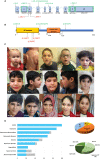RSRC1 loss-of-function variants cause mild to moderate autosomal recessive intellectual disability
- PMID: 32227164
- PMCID: PMC7174030
- DOI: 10.1093/brain/awaa070
RSRC1 loss-of-function variants cause mild to moderate autosomal recessive intellectual disability
Figures

References
-
- Chen L, Li W, Qiu W, Ren W, Li Q, Han B, et al.RSRC1 SUMOylation enhances SUMOylation and inhibits transcriptional activity of estrogen receptor β. FEBS Lett 2015; 589: 1476–84. - PubMed
-
- Maddirevula S, Al Zahrani F, Anazi S, Almureikhi M, Ben-Omran T, Abdel-Salam GMH, et al.GWAS signals revisited using human knockouts. Genet Med 2018; 20: 64–8. - PubMed
Publication types
MeSH terms
Substances
Grants and funding
LinkOut - more resources
Full Text Sources
Molecular Biology Databases

